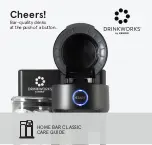
HR Series
Operating & Safety Instructions
English/USA – 11/06
19
4 Operation
4.1
CONTROL CIRCUIT COMPONENTS
4.1.1
MAIN CONTROL BOARD
: -
Situated under the left-hand superstructure cover, the encapsulated control
board comprises a PCB (printed circuit board) design which incorporates all of the relays to control the
machine operation. The control boards are common to all models, and contain functions which might
not be utilised on your particular machine.
4.1.2
TILT ALARM: -
Fitted to the superstructure underneath the base controls cover, a solid state sensor
which monitors the inclination of the machine. It directly controls the BRV (Brake Release Valve) and
when the platform is in use, i.e. Booms are raised, if the inclination exceeds the pre-set limit, it will
disable the drive to the machine and sound the alarm. In order to recover the machine, the platform
operation is unaffected, allowing the operator to restore drive when the machine is stowed. It is then
possible to drive back onto level ground, fully restoring machine operation.
4.1.3
SOUNDER: -
Situated on the side of the base control box is a small piezo electric sounder, which is
used to provide an intermittent alarm whenever the machine is in operation. Pushing the green "power
control" button, or depressing the foot switch in the cage (if fitted) will energise this sounder. This
serves to warn personnel of the operation of the machine.
4.1.4
KLAXON: -
Also located on the back of the base control box is a klaxon, which performs several
functions.:
Firstly, it can be used as a manual alert, by pushing the "Horn" button at the Platform control position.
Secondly, it is this device which sounds continuously if the Tilt Alarm Sensor detects excessive
inclination, with the booms raised. Thirdly this will sound when the low fuel warning light comes on.
Lastly, it is linked into the battery management system, such that when low battery state is reached the
"pulsing" of the D.C. motors is mimicked by the Klaxon, reinforcing the message to the operator to
charge the machine.
4.1.5
MAIN CONTROL VALVE: -
The main control valve contains the ON/OFF solenoid and PRV for the
boom controls. It also contains the steer valve and the brake release system. If any of these functions
need to be overridden this can be done by using the hand pump, (see Section 4.2).
4.1.6
SUSPENSION CONTROL VALVE (OPTIONAL ON 2X4 AND STANDARD ON 4X4):
-
This valve controls
the cylinders on the unique suspension system. This system will only be active when the booms are in
the down position and the telescope is retracted.
4.1.7
BOOM-SWITCHES:
-
Mounted on the tele-knuckle and links knuckle, and operated by any of the
booms raising and/or the telescopic boom going out, these switches control both the operation of the
Tilt Alarm Sensor, and the speed control function. With the booms in the stowed position, the Tilt
Alarm Sensor is by-passed, allowing the machine to negotiate slopes in excess of the permissible
working angle, without isolating the drive function. At the same time, High drive (Depicted by a Hare
Icon) is possible, as is fast throttle on those machines so equipped. When the booms are raised or the
telescope is out, the Tilt Alarm Sensor becomes activated, only slow speed operation is possible and
only Low drive (Depicted by a Tortoise Icon) is permitted. When the booms are raised and the
telescope out is engaged the machine goes to a third slower speed. These control functions are of
primary importance to safety of the machine and operator, under no circumstances should this control
function be isolated or by-passed.
Содержание HR15
Страница 2: ......
















































